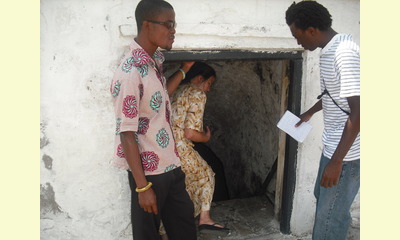|
|
Facing the Past, Moving Towards the Future
an article by Enoch Holu
I was privileged to undertake a project on the
history of the Atlantic Slave Trade during my
vacation in Ghana this summer. Apart from getting
to see my family after two years, the best part of
the vacation was the project. I am very grateful
to the Wesson Honors Program at Colby-Sawyer
College for providing the funds to make the
project a success. 
A Slave Dungeon at the Cape Coast Castle
click on photo to enlarge
The title of the project was “Tracing an African
Trail of Tears.” I come from Gwollu, a small town
in the northern border of Ghana. Gwollu is one of
the most important towns in the history of the
Trans-Atlantic Slave Trade, because it is one of
the few towns in Africa to build a well to defend
its inhabitants against salve raids during the
period of the trade. But before the wall was
built, a lot of men, women and children were taken
away by African slave raiders who later sold their
victims to the European merchants at the coast.
The aim of my project was to physically trace the
route through which the captives were transported
to the coast for shipment to the New World. Along
the way, I visited many slave markets and castles.
The interesting thing as I got to all these
tourist sites was the variety of tourist; they
came from all walks of life. I was particularly
fascinated by the reactions of the European and
African tourist that I met at the castles. As the
tour guide took us around and narrated the inhuman
treatment that was meted out to the slave inmates
of the castle, I could sense the discomfort among
both the African and European tourists. Both
groups of tourists felt guilty for the
contribution their ancestors made to this horror
of human history. At the end of the tour at the
Cape Coast Castle when the tourist were asked for
final comments, the general consensus was that we
should make sure that this never happens again in
human history. This was when I realized that these
castles provide a platform for both Europeans and
Africans alike to face the horrible past of the
slave trade and figure out a way forward for all
of humanity.
|








|
DISCUSSION
There is no question yet associated with this article.
* * * * *
Latest reader comment:

|
|









